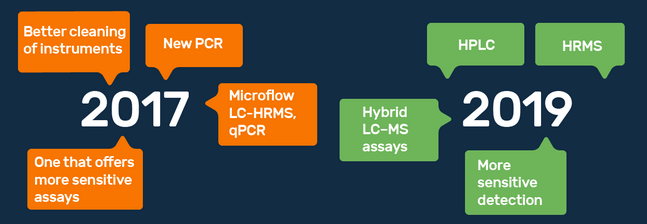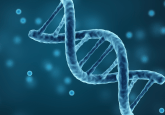Infographic commentary: oligonucleotide trends by Zamas Lam

QPS (DE, USA) validated our first ASO plasma PK assay in 2002 using LC–MS/MS on a triple quadrupole. The ‘state-of-the-art’ technology at that time was hybridization-ELISA while LC–MS was an unknown ‘possibility’. Fast‑forward 17 years and we have worked on over 50 ASO, siRNA, PEGylated aptamers, mRNA and vectors. The lesson learned is there is no one best method for bioanalysis, as hybridization‑ELISA, UPLC–HRMS, UPLC–MS/MS, hybridization-LC-FLD, LC‑UV and qPCR are all viable techniques. It is the physicochemical property of the oligonucleotides, mRNA and vectors that determines the methodologies. This specific commentary addresses the changes in bioanalysis of oligonucleotides over the past few years.
 Although the bioanalytical technology has improved dramatically over the past 17 years, the fundamental differences between hybridization-ELISA verses chromatography has not changed. Hybridization‑ELISA generally has better sensitivity while chromatography methods have better selectivity. Hybridization‑ELISA using electrochemiluminescence detection can regularly achieve low pg/mL range. Although the LLOQ is at the low ng/mL for the previous generation of UPLC–MS, the newer UPLC–MS, that have been commercialized in the last 2 years, can reach down to mid to low pg/mL range and thus negating the previous sensitivity advantage of hybridization-ELISA.
Although the bioanalytical technology has improved dramatically over the past 17 years, the fundamental differences between hybridization-ELISA verses chromatography has not changed. Hybridization‑ELISA generally has better sensitivity while chromatography methods have better selectivity. Hybridization‑ELISA using electrochemiluminescence detection can regularly achieve low pg/mL range. Although the LLOQ is at the low ng/mL for the previous generation of UPLC–MS, the newer UPLC–MS, that have been commercialized in the last 2 years, can reach down to mid to low pg/mL range and thus negating the previous sensitivity advantage of hybridization-ELISA.
Hybridization‑ELISA assays consist of many formats, such as sandwich, competitive, ligation and dual ligation assays. They all take advantage of a complementarily to capture the oligonucleotides and have another complementary strand with a probe. The sandwich and the competitive hybridization formats are more general and can capture parent and potential metabolites. The hybridization-ligation format was developed to target the 3’-end of the oligonucleotides, which means the assays can be distinguished from the parent oligonucleotides from the 3’-end N‑1, N‑2, N‑3… metabolites. The main drawback with this format is it cannot be used with any oligonucleotide chemistry that modify the 3’-end. The dual ligation hybridization format targets both the 3’-end and the 5’-end of the oligonucleotides and therefore have even more specificity than the hybridization-ligation format.
UPLC–MS oligonucleotide quantitation has undergone a dramatic change over the past 5 years. In the early 2000s, the only viable quantitative mass spectrometers were unit resolution triple quadrupole; however, with the advent of faster electronics, high-resolution mass spectrometers, such as ion-traps and quadrupole time-of-flight (qToF), seem to be the mass analyzers of choice. The advantages of triple quadrupole are lower instrumentation cost, lower operating cost, ease of use, higher availability and more trained personnel; while the two main disadvantages are the difficulties in trouble shooting a failing method and the simultaneous quantitation of parent and metabolites. The main advantages of HRMS is the ≥35,000 resolution to resolve the isotopic pattern, which easily affords the simultaneous quantitation of parent and metabolites and in separating the various cationized species of the same oligonucleotides; while the disadvantages are high operating cost, difficulties in training qualified personnel and the high data density associated with full scan quantitation.
There is an interesting divergence of opinion on whether ion-traps or qToF mass spectrometers are better for oligonucleotides quantitation. The resolving power of an ion-trap is a function of mass and scan speed and the most common 18 Hz instruments have 120K resolving power at 200 amu. However, the resolution goes down as the mass goes up. On the other hand, qToFs regularly function at 40,000 resolving power and have uniform resolution across all masses. As most chromatographic separations are performed by UPLC, and the peak width is ~2 seconds, therefore, the working resolution for both ion-traps and qToF is effectively at ~35,000 resolving power. There is a misconception that higher resolution is better, in fact, there is major expense associated with running HRMS on a full scan mode. The data file size for a batch of three 96‑well plates from a triple quadrupole is ~2–3 MB, while it is ~4–5 GB for a HRMS running at 35,000 resolving power. The higher the resolution the bigger the data file size, and the logistics and infrastructure necessary for uploading the files, data processing, archiving and downloading back to the instrument for regulatory audits needs to be considered as part of the decision process.
The choice of LBA or chromatography for bioanalysis is really based on the sensitivity requirement, the potential off-target toxicity in different organs, which need quantitation and an understanding of metabolism, along with familiarity of the techniques employed. There have been reciprocal arguments that transferring validated serum hybridization-ELISA methods to various tissues homogenates is less demanding than transferring validated plasma LC–MS methods. However, in our hands we found as long as the appropriate attention has been paid to homogenization, sample preparation and method development transferring hybridization-ELISA method or LC–MS method between different matrices takes about the same amount of time and the quality of the data for both techniques is well within regulatory requirement. What is important is to plan and to have adequate well-trained personnel and appropriate instrumentation, as often oligonucleotides and their metabolites are highly distributed across all matrices. We have worked on up to 20 different tissues during preclinical and nonclinical studies.
With each new generation of oligonucleotides, endo- and exo-nucleases metabolism has contributed less and less to the clearance mechanism and the latest generation of oligonucleotide drug candidates generally show fewer N‑1, N‑2, N‑3, … metabolites. Therefore, some believe it is best to just analyze the parent for IND-enabling and Phase I/II studies and leave metabolite profiling and quantitation until after positive Phase II PoC studies. Chromatography methods can simultaneous detect and quantitate the parent and each individual metabolites while hybridization‑ELISA cannot. If the oligonucleotides potentially have a fair amount of metabolism, it is more straightforward to develop and validate LC–MS methods to capture the full PK profile of the parent and metabolites. If hybridization‑ELISA is the bioanalytical platform, then after Phase II PoC, additional chromatographic methods may be needed.
In the early 2000s, it was uncertain if oligonucleotides trigger immune response and there was uniform rule for anti-drug antibody (ADA) assays. However, it is now clear that oligonucleotide drugs do solicit immune response. Therefore, it is highly advisable to initiate scientific discussions with the regulatory agencies on the merit of potentially developing and validating ADA assay in parallel to PK assay.
As oligonucleotides are becoming a more common drug modality, there is some ambiguity on what criteria should be used for method validation. Within QPS, we use the LBA criteria for hybridization‑ELISA methods and the chromatography criteria for LC–HRMS or LC–MS/MS or hybridization‑LC-FLD or LC-UV assays.
With six oligonucleotides that have been approved, at least another 20 in various stages of preclinical and clinical development, and the increasing interest in gene therapy and rare disease, we should expect to see corresponding improvement in bioanalytical platforms, the surrounding supporting reagents and more appropriate regulatory guidance on method validation in the next few years. Maybe by 2025, oligonucleotides will be just another common drug modality that will solicit less excitement in the pharmaceutical industry.






